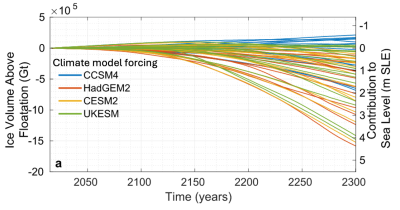Extending Projections of the Antarctic Ice Sheet Contribution to Sea-Level Rise to 2300
A model intercomparison of the future of the Antarctic Ice Sheet through 2300 comprised 16 ice sheet models, including E3SM’s ice-sheet component, MALI, performing experiments forced by atmosphere and ocean conditions from 4 climate models run through 2300. While the sea-level contribution from Antarctica under high greenhouse gas scenarios is less than 0.3 m at 2100, it ranges from -0.6 to over 4 meters by 2300, indicating large uncertainty in future Antarctic Ice Sheet behavior.
Sea-level rise from ice sheets due to climate change may grow exponentially beyond 2100, making longer timescales critical to consider. The wide range of ice-sheet model projections stems primarily from a choice of ice-sheet model, indicating that improvements to the historical calibration of ice-sheet models and uncertainty quantification are critical for projections to be actionable. These are both current priority areas for E3SM’s MALI ice-sheet model.
The Ice Sheet Model Intercomparison Project for CMIP (ISMIP) is a coordinated community modeling activity to project the sea-level contribution from the ice sheets and constitutes the primary contribution of ice sheets to the Intergovernmental Panel on Climate Change assessment reports. The previous ISMIP assessment only projected through 2100, leaving the long-term Antarctic contribution to sea-level rise largely unconstrained. This new assessment extends the ice-sheet modeling protocol through 2300, utilizing atmosphere and ocean output from 4 climate models that have run long-term climate projections under high greenhouse gas emissions scenarios. A set of 15 experiments was performed all or in part by 16 ice-sheet models, including E3SM’s ice-sheet component, MALI. The MALI configuration was among the ice-sheet models with the highest resolution and best match to historical observations and the model with the highest fidelity velocity solver. At 2300, the Antarctic Ice Sheet sea-level rise contribution in the ensemble under high greenhouse gas emissions ranges from -0.6 to 4.4 meters, with the MALI projections ranging from 0.8 to 3.0 meters. Projections including prescribed ice‐shelf collapse increase sea-level rise by an additional 1.1 meters at 2300, averaged across models. About one-third of participating models, including MALI, predict the collapse of West Antarctica by 2300 under high emissions. The largest uncertainty in these projections is the choice of ice-sheet model, followed by the choice of climate forcing, indicating the need for formal uncertainty quantification and coupling of ice-sheet models to climate models.

